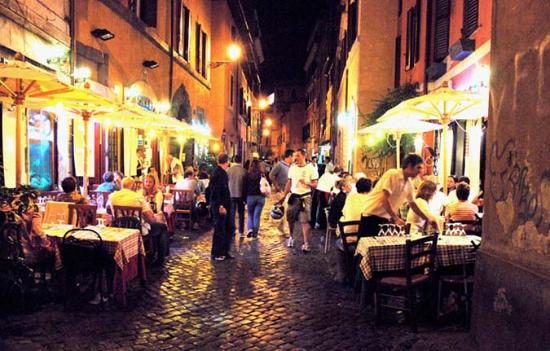I would classify myself as a fast walker. I usually like to get places quickly if I'm walking, and sometimes I'm running late so I walk super fast! My mom also walks incredibly fast for how short her legs are. I remember a trip to the zoo when I was in high school and my grandparents were visiting and my grandpa walked really slowly. I realized the slower I walk, the more it exhausts me and after a short afternoon at the zoo when we didn't do a whole lot, I was zonked.
Rome is making me change my pace.
1. It's hot. If I walk at my normal pace I get sweaty and exhausted really quick! Today it's 93 and humid- and it's been this hot for two weeks. I have to walk slow to keep from sweating through all my clothing and getting dehydrated.
2. Trastevere is carpeted by small, uneven cobblestones. Walking fast makes it more likely you will trip, and the Italians will laugh at you. Walking slow helps you keep an eye on the ground so you don't catch the tip of your shoe in a crack.
sidenote: Italian women look amazing all the time. And that means they wear heels and wedges the way I wear flip flop. Watching an older women walk around on jagged cobblestones in heels is alternately terrifying and incredibly impressive.
3. Everyone else walks slow. When the streets get crowded attempting to walk faster than the collective pace is useless.
I'm starting to really enjoy it. Romans have a tradition of taking a passaggiata or an evening walk. Before dinner or after dinner, people just walk around together. I walk a lot during the day when I'm exploring but I always love to take an evening and just people watch and peek in the restaurants and gelatarias. It's a tradition we don't have in the states, unfortunately because most people would just take a walk around their suburban neighborhood. There's not as much to gawk at!
Rome is making me change my pace.
1. It's hot. If I walk at my normal pace I get sweaty and exhausted really quick! Today it's 93 and humid- and it's been this hot for two weeks. I have to walk slow to keep from sweating through all my clothing and getting dehydrated.
2. Trastevere is carpeted by small, uneven cobblestones. Walking fast makes it more likely you will trip, and the Italians will laugh at you. Walking slow helps you keep an eye on the ground so you don't catch the tip of your shoe in a crack.
sidenote: Italian women look amazing all the time. And that means they wear heels and wedges the way I wear flip flop. Watching an older women walk around on jagged cobblestones in heels is alternately terrifying and incredibly impressive.
3. Everyone else walks slow. When the streets get crowded attempting to walk faster than the collective pace is useless.
I'm starting to really enjoy it. Romans have a tradition of taking a passaggiata or an evening walk. Before dinner or after dinner, people just walk around together. I walk a lot during the day when I'm exploring but I always love to take an evening and just people watch and peek in the restaurants and gelatarias. It's a tradition we don't have in the states, unfortunately because most people would just take a walk around their suburban neighborhood. There's not as much to gawk at!
















































